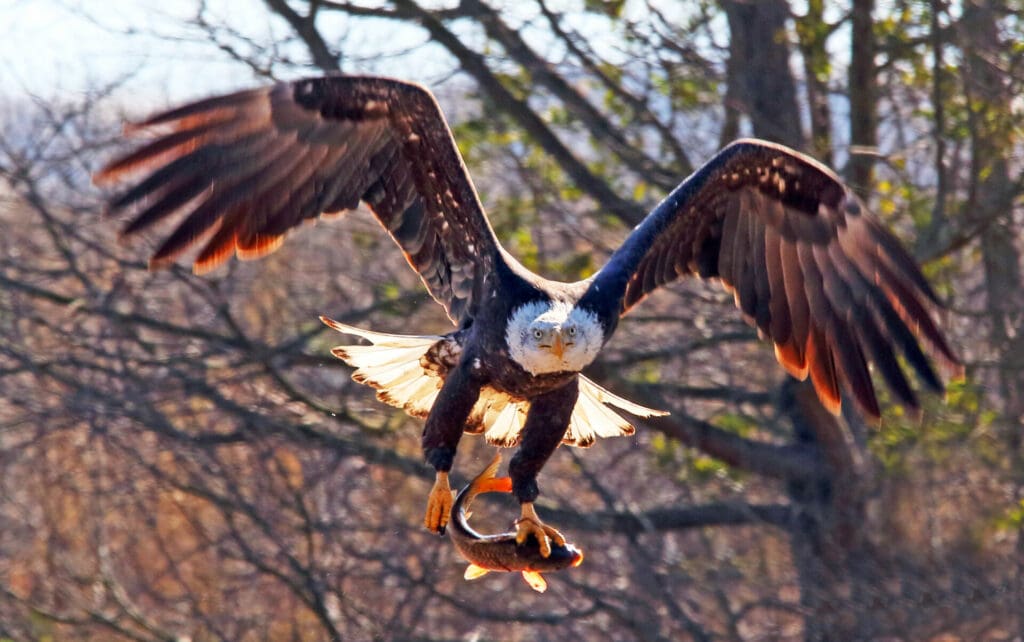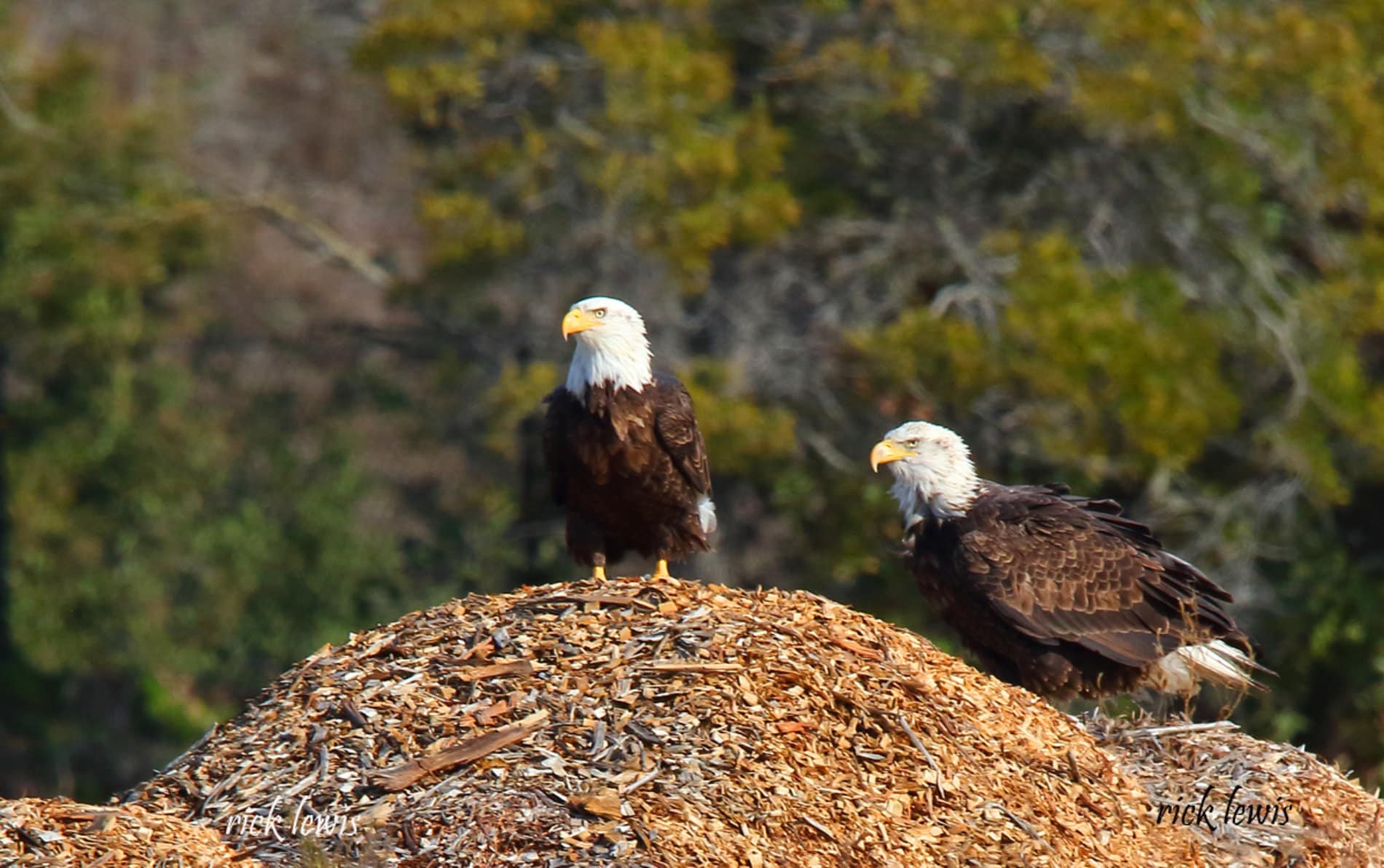Bald Eagles at Corica Park Golf Course
Update: Bald Eagle egg(s) have been laid! More info below.
Bald Eagles are nesting at Corica Park golf course in Alameda, and we couldn’t be more excited about it! Bald Eagles, a symbol of our nation, were once rare in most parts of the US, including in the San Francisco Bay Area, due to pesticides, habitat destruction and hunting. Fortunately, they have made a tremendous comeback through environmental protections, including the banning of DDT. In recent years the Bay Area has seen Bald Eagle nests in Milpitas and at Lake Chabot, Ardenwood and Del Valle Regional Parks. Now a pair are tending eggs in a nest in Alameda in the middle of our dense urban Bay Area.
While Bald Eagle populations are expanding, these birds still need the support of conservation efforts, and continue to be protected by the Bald and Golden Eagle Protection Act and Migratory Bird Treaty Act. As of March 2023, the Alameda eagles have accepted some activities in the vicinity of their chosen nest, but careful precautions are needed through their nesting period.
Update: Our eagles have eggs! On March 1, for the first time, one of the GGBA monitors observed incubation activity in the eagles’ nest on the North Course, which has developed into their preferred nest. We have observed that one of the eagles is on the nest almost all the time, and the eagle tending the eggs is hunched down in the nest, frequently almost invisible except when moving. According to the Cornell Laboratory of Ornithology, the incubation period is 34 – 36 days. If we are correct about the date incubation started, and all goes well, the eggs would be expected to hatch in the first part of April. The nestlings will likely be invisible to us in the nest for at least the first 10 days after they hatch.
The typical number of eggs laid by Bald Eagles is between 1 and 3. We cannot tell how many eggs our pair is incubating. The pair shares parenting duties, switching places at the nest so each has a chance to hunt, eat and take a break.
The female of our pair has been identified by the Milpitas eagle watchers as Big Junior, who was hatched in Milpitas in March 2019. (Thank you, Milpitas!) The identification was made using some unique physical characteristics she has. This means she is young to be breeding, and this is very likely her first nesting attempt. We do not yet know anything of the origins of the male.
The eagles also built a nest on the South Course, but they are not using it for eggs this year. A pair building more than one nest is not uncommon; they may switch between alternate nests in different years.
We are holding a limited number of small walking field trips to see the eagles, which require advance registration here. The trips take place on Monday or Tuesday when the North Course is closed to golfers. We need to limit the number of people on each field trip and the number of trips to avoid disturbing the eagles.
We currently have monitors out at the nesting site on a regular basis. For more information on the Bald Eagles at Corica please contact Golden Gate Bird Alliance’s Friends of Alameda Wildlife Reserve (FAWR) at FAWR@GOLDENGATEAUDUBON.ORG
Guidelines to Keep the Bald Eagles Safe and Happy
There is no unauthorized admittance to the golf course. Do not enter the golf course for photography or bird watching unless you are registered for a bird walk. We have carefully planned the walks to keep visitors and eagles safe.
Learn where you can see the eagles from outside the course HERE.
- If an eagle is on the ground (perhaps seeking nesting material or food), do not move any closer to it.
● If there are barriers in the area of the nesting trees, respect the barriers and do not enter the restricted area.
● Do not attempt to climb a nest tree.
● Do not attempt to lure the birds with food or other attractants.
● Eagles, like other raptors, may try to eat anything they see. Trash can harm them, so please pick up after yourself and safely discard any litter that you may see.
● If an eagle is stressed, it may bob its head, make vocal sounds, or leave the nest. If you see any of these signs, please gently and quietly withdraw from the area of the eagles.
● Do not aim balls toward the birds or the nest area.
● Do not fly drones anywhere around the eagles. Drones are already prohibited in the course area because of the nearness of the airport.
The federal Bald and Golden Eagle Act prohibits disturbing Bald Eagles, which includes interfering with nesting; a violation of this Act can result in a fine of $100,000 or imprisonment.
Information on Corica Park
Greenway Golf, which manages Corica Park, considers the true owners of any asset owned by a municipality to be the residents of that municipality. So for Corica Park, the true owners are the residents of Alameda. The Greenway team are simply stewards of Corica Park who seek to create a welcoming, sustainable open space for everyone. Their mission is to unlock the potential of golf course space in a manner that harmonizes a high-quality golf experience, holistic environmental restoration and revitalization, sound fiscal management, and social inclusiveness for all. Learn more: https://www.coricapark.com/mission/.
General Information on Bald Eagles
Bald eagles generally build their first nests at five or six years old. By then, they have their adult plumage with a very dark brown body and a white head and tail. Their nests are usually high in tall trees, preferably near a lake, estuary, or other water, where they can hunt for fish. The eagles typically use their nest for multiple years and enlarge it each year. Nests may reach 10 feet across and weigh a half ton.
In California, the breeding season typically lasts from January through July. The female usually lays two eggs and both adults incubate the eggs for about 35 days. After the eggs hatch, both parents feed the chicks until they fledge at 8 to 14 weeks. The parents continue to feed the fledglings as they teach them to hunt for themselves. The young are on their own a month or so after fledging.
Female eagles may weigh 14 pounds and have a wingspan of eight feet. Male eagles are smaller, weighing as much as 10 pounds and have a wingspan of six feet. Pairs typically mate for life, and they can live for 15 to 25 years in the wild. In addition to fish, bald eagles will also feed on ducks, geese, turtles, rabbits, snakes, other small animals, and carrion.

Bald Eagle numbers have rebounded magnificently from the 1960s, when they were close to extirpation in the lower 48 states. When America adopted the bald eagle as a national symbol in 1782, anecdotal accounts indicated the country may have had as many as 100,000 nesting eagles. During the 1800s and the first half of the 20th century, the numbers of eagles’ prey species declined, a great deal of habitat was destroyed, and eagles were believed to be livestock marauders and shot. Congress passed the Bald Eagle Protection Act in 1940, finding that the species was in threatened with extinction. After World War II, the use of DDT and other pesticides began, adding a serious additional threat. The Bald Eagle population’s all time low was in 1963 when only 417 nesting pairs of bald eagles were known to exist. In 1967, the Secretary of Interior listed bald eagles in large parts of the US under the Endangered Species Preservation Act of 1966. In 1972, the Environmental Protection Agency banned the use of DDT and some related pesticides in the United States, beginning the recovery of the Bald Eagle in the lower 48. (Eagles had remained robust in Alaska and do not occur in Hawaii.)
Additional federal protections were enacted, including the Endangered Species Act in 1973. Listing the eagles as endangered under that Act, and hard work by wildlife agencies and conservationists helped the eagles fight their way back. Now the US Fish and Wildlife Service has estimated that in 2018-19, the Bald Eagle population in the lower 48 had increased to 316,700 individuals, including more than 71,000 breeding pairs, demonstrating that nature can rebound when contaminants are removed and habitat is preserved.
Unfortunately lead from ammunition has poisoned and is still poisoning bald eagles throughout the United States when eagles feed on contaminated prey or carcasses, and habitat loss remains challenging for eagles and most birds. We need everyone’s help to protect the eagles and other birds who have made Alameda their home.
March 2023
Other Bald Eagle Information Resources:
Bald Eagle Fact Sheet, from the U.S. Fish and Wildlife Service: https://www.fws.gov/sites/default/files/documents/bald-eagle-fact-sheet.pdf
General information on Bald Eagles: https://www.allaboutbirds.org/guide/Bald_Eagle/id
Bald Eagles in California: https://wildlife.ca.gov/Conservation/Birds/Bald-Eagle

